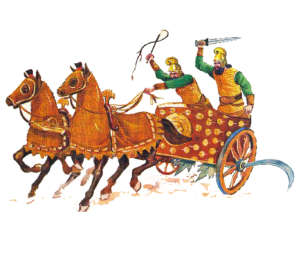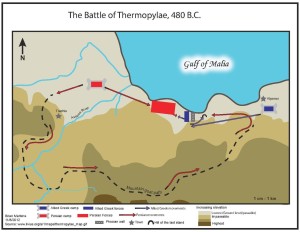As noted in the “A New Western Way of War?” introduction page and the “West” page beneath it, the armies of the hoplites consisted of men who took pride in their role in the phalanx. They held the ideal that being slain in battle for their city-state was a death of honor and glory. These notions of bravery and pride were not always found in the armies of the Near East, the Persian Empire, which often used several different methods to conduct its battles.
The Persian Empire’s military success came from the mass amounts of soldiers in its army. The large territory of the empire allowed for a Great King to raise a horde of more than 150,000 troops at a time. Unlike the heavily armored infantry of the hoplites, the Persian soldiers were lightly armored and used mainly wicker shields. A large emphasis was put on the utilization of cavalry for quick, decisive victories. Chariots were also used as more of an intimidation device, especially with the addition of the terrifying, though largely ineffective, scythed wheels.

[21] An illustration of a Persian formation. Heavy soldier in front with archers in the middle and light infantry in the rear.
If victory was not guaranteed, the Persians would try to save themselves, abandoning their positions on the battlefield. The best example of an individual Persian’s ideal of self-worth could be seen at the Battle of Gaugamela, between Alexander the Great and Darius III of Persia. Darius fled when his formation was defeated by Alexander’s cavalry. He turned and fled the field, with his army following suit. He didn’t get very far, however, for was killed by a member of his own army, Bessus, whose intent was to earn some favor with Alexander the Great.
The success of the many eastern armies, including the Persian Empire, relied heavily on ambushes, flanks, skirmishes, and deceit whenever possible. Frequent and small skirmishes between the Near East armies meant that individual battles had little sway in the tide of a war, as more men could be conscripted to replace the dead ones at a steady rate. Under the principles of the western way of war, they were seen as having little honor for they would not stand and fight solely head-on nor would they die with dignity on the field of battle.



